Adaptive kayaking equipment opens water adventures to paddlers with limited mobility through specialized modifications. You’ll find adjustable outriggers for stability, customized seating systems with trunk support, and transfer solutions like benches and slings that make getting on and off easier. Front-entry life vests and adapted paddles with improved grips enhance your safety and control. Community programs offer training with supportive environments where you can build skills gradually. The right equipment transforms impossible waters into accessible freedom.
Choosing the Right Adaptive Kayak for Your Mobility Needs
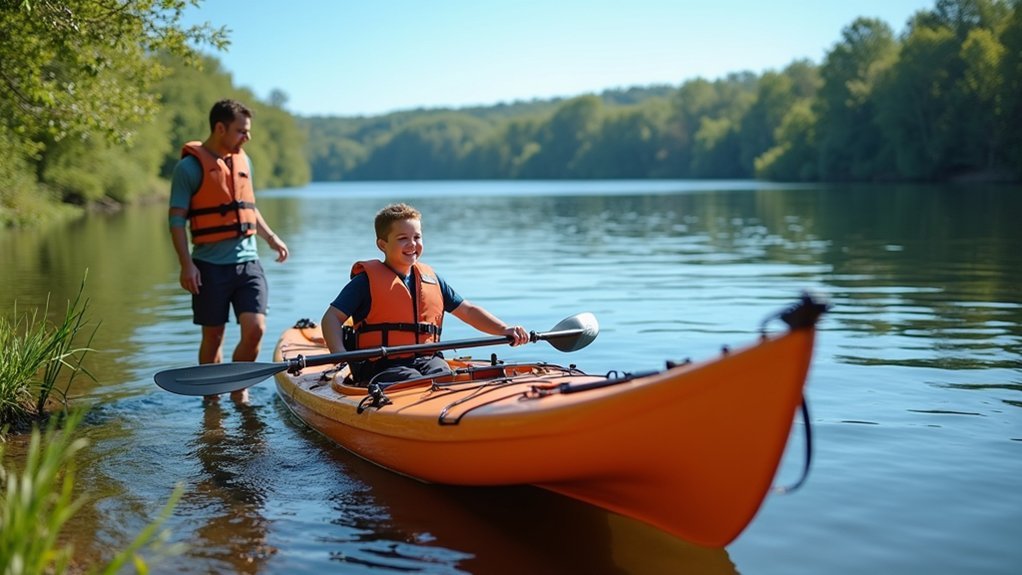
Why let mobility challenges prevent you from experiencing the freedom of kayaking?
Today’s adaptive kayaks offer innovative features designed specifically for paddlers with limited mobility.
Look for models with adjustable outriggers—those small floats attached to the sides—which dramatically improve stability and can be customized to match your specific needs.
Adjustable outriggers transform standard kayaks into confidence-building vessels, offering personalized stability for every adventure.
For easier access, prioritize kayaks with specialized entry systems that facilitate wheelchair transfers using gangways and roll cages.
If you have limited upper-body control, consider models with integrated joystick steering that allows you to navigate from a seated position.
Many adaptive kayaks also feature removable or adjustable components to accommodate your unique requirements.
Remember that the right kayak isn’t just about accessibility—it’s about finding equipment that empowers your independence on the water. With products like the Versa Paddle, no one needs to be turned away from enjoying the kayaking experience regardless of their disability.
Essential Seating Systems and Support Modifications
When comfort meets function in adaptive kayaking, your entire experience transforms from challenging to enjoyable. Your seating system serves as the vital interface between you and your kayak, providing stability, support, and comfort during your adventure.
| Seating Component | Primary Benefit | Best For |
|---|---|---|
| Custom Cushions | Pressure distribution | Extended trips |
| High-Back Seats | Spinal alignment | Weak core strength |
| Trunk Controls | Enhanced stability | Balance challenges |
You’ll find ergonomic features like adjustable lumbar support and breathable materials indispensable for long paddles. Don’t overlook safety enhancements such as anti-slip surfaces and emergency release mechanisms. For maximum effectiveness, make certain your seating system integrates with other adaptive equipment like paddle holders and accessory mounts. The right combination of support modifications will greatly improve your kayaking independence and enjoyment. Many adaptive seating systems are designed to facilitate equal participation for paddlers with varying levels of mobility.
Stability Solutions: Outriggers and Flotation Devices
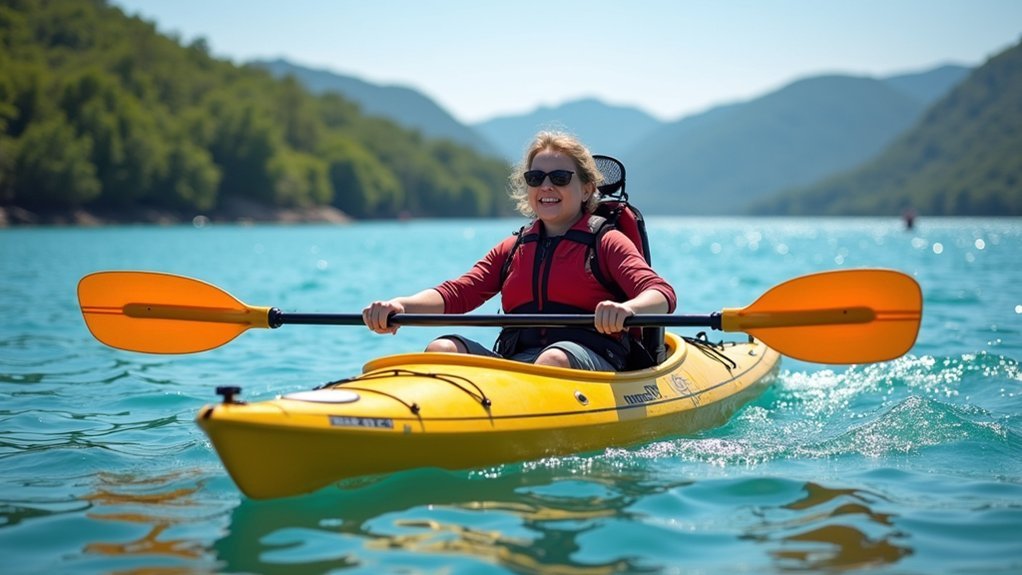
Outriggers provide essential stability for your kayak by extending pontoons on either side, creating a wider base that prevents tipping even during challenging maneuvers.
You’ll find these stability aids particularly valuable if you have limited mobility, as they allow you to focus on paddling rather than constantly maintaining balance. For individuals with paralysis or limited mobility, these adaptive paddling programs commonly incorporate outriggers as a safety enhancement.
Flotation devices complement outriggers by adding buoyancy to your kayak, ensuring your safety in rough waters and offering peace of mind during your adaptive paddling adventures.
Outriggers for Balance
For individuals with limited mobility, maintaining balance on the water presents one of the greatest challenges to enjoying kayaking. Outriggers provide an effective solution by creating additional stability points that considerably reduce the risk of tipping over.
You’ll find these attachments transform your kayaking experience, offering independence and confidence on the water. These stability systems help deliver the sense of freedom that makes adaptive kayaking so valuable for those with physical disabilities.
When considering outriggers for your kayak, look for:
- Adjustable arms that adapt to different water conditions
- Portable designs for easier transportation
- Compatibility with your specific kayak model
- Proper installation options for ideal performance
- Customizable features to match your unique mobility needs
With outriggers properly installed, you can focus on paddling techniques rather than worrying about capsizing, opening up opportunities for fishing, photography, and simply enjoying nature from a stable platform.
Flotation Safety Systems
Beyond the stability provided by outriggers, extensive flotation safety systems serve as essential lifelines for kayakers with limited mobility. You’ll need properly fitted PFDs that accommodate your specific needs while ensuring full range of motion for paddling. Performance levels like Level 70 PFDs offer good mobility while still providing enough buoyancy for quick rescue in calm waters.
| Device Type | Benefits | Best For |
|---|---|---|
| Standard PFDs | Reliable flotation, no activation needed | Most paddlers |
| Inflatable PFDs | Lightweight, less bulky | Experienced kayakers |
| Hybrid PFDs | Combined security with comfort | All-day paddling |
| Automatic Inflatables | Self-activating in water | Those with limited arm strength |
| Adaptive PFDs | Side supports, additional trunk stability | Severe mobility limitations |
When selecting flotation systems, consider your mobility challenges, paddling environment, and the presence of support staff. Look for Coast Guard certification and features like accessible straps that you can adjust independently.
Specialized Paddles and Grip Adaptations
While traditional kayaking paddles may present challenges for those with mobility limitations, specialized adaptive paddles and grip modifications have revolutionized accessibility on the water.
You’ll find equipment designed specifically to accommodate different ranges of motion and strength levels, ensuring you can enjoy kayaking regardless of physical constraints.
- Angle Oar systems allow paddles to remain angled downward or straight, reducing the motion required
- Active Hands grip aids provide secure paddle control even with limited grip strength
- Versa Paddles require smaller range of motion, perfect if you have restricted arm movement
- Stabilizing features prevent wobbling, offering confident strokes with less effort
- Lightweight materials in adaptive paddles help prevent fatigue during your paddling adventure
These adaptations work with both sit-in and sit-on-top kayaks, making the water accessible to everyone. The gentle rotary movement mimics pedaling a bicycle, creating an intuitive paddling experience that reduces strain on the body.
Getting In and Out: Transfer Systems That Work
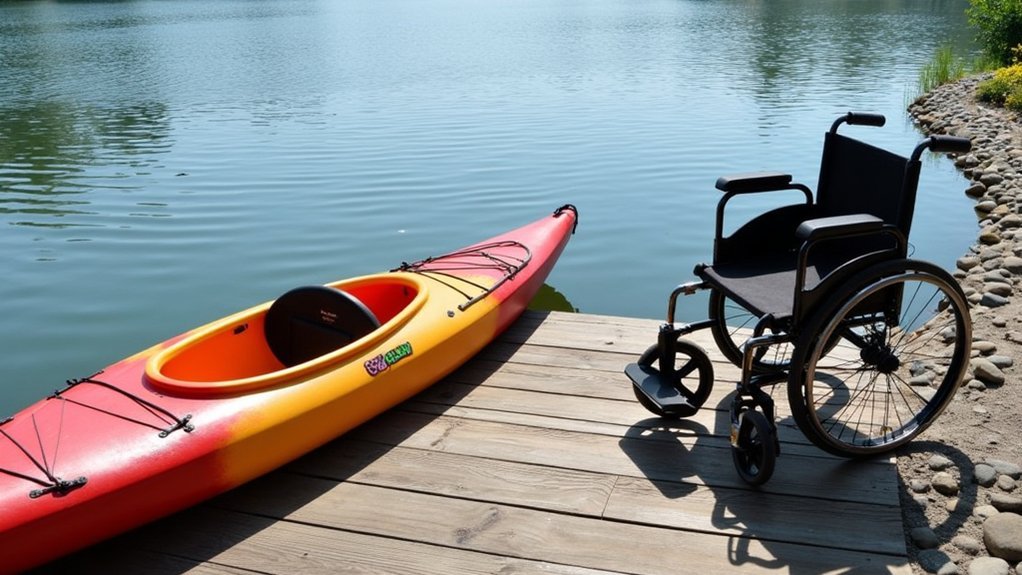
Entering and exiting a kayak presents one of the biggest challenges for paddlers with limited mobility, but modern transfer systems have made this process considerably more accessible.
Transfer benches provide a stable surface if you have upper body strength but limited lower mobility, enabling greater independence during shifts.
For those needing full support, sling systems operated by assistants or mechanical options like Hoyer lifts can safely move you in and out of your kayak. These come in electric, battery-powered, and manual hydraulic versions.
Specialized kayak carts and ramps allow you to roll directly to the water’s edge, minimizing the need for lifting. Sit-on-top kayaks are particularly suitable for transfers as they offer more open deck space and eliminate the need to maneuver into an enclosed cockpit.
When combined with accessible dock adaptations featuring non-slip surfaces and ADA-compliant designs, you’ll find the shift between land and water smoother than ever.
Accessible Launches and Shore Infrastructure
Three essential components make up effective accessible launch systems: specialized infrastructure, thoughtful design, and regulatory compliance.
Accessibility in water recreation depends on specialized infrastructure, thoughtful design and strict regulatory adherence.
You’ll find these adaptive launches increasingly available at public parks and waterways across the country, making water adventures possible regardless of mobility challenges.
These specially designed platforms offer:
- Non-slip surfaces to prevent falls during kayak entry and exit
- Adjustable height ramps accommodating various mobility devices
- Stability features supporting safe transfers from wheelchairs to watercraft
- Handrails and support bars providing additional assistance
- Wide, unobstructed pathways for easy navigation
Look for ADA-compliant launches manufactured by companies like BoardSafe Docks and EZ Dock.
Many locations also provide accessible parking, restrooms, and clear signage to enhance your paddling experience.
These inclusive designs benefit everyone, creating community spaces where all paddlers can enjoy water recreation together. Recent installations at locations like Syracuse Inner Harbor and Weeks Bay demonstrate the growing nationwide accessibility movement in aquatic recreation.
Safety Equipment Tailored for Limited Mobility Paddlers
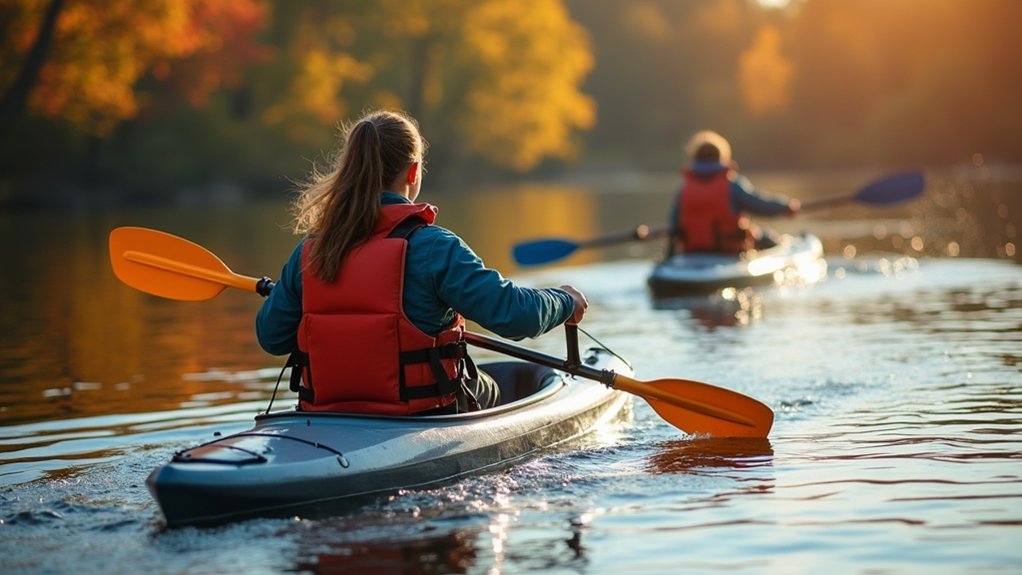
When kayaking with limited mobility, you’ll need specialized life vests designed with front-entry features and adjustable side panels for comfortable wear.
Quick-release safety tethers can secure you to your kayak while allowing immediate detachment in emergency situations.
Assistive signaling devices, including waterproof whistles and high-visibility flags, guarantee you can effectively communicate distress even with restricted movement.
For maximum safety, it’s crucial to always wear a PFD regardless of your swimming ability or water conditions.
Specialized Life Vest Options
Safety on the water begins with the right personal flotation device, and paddlers with limited mobility need vests specifically tailored to their unique requirements.
Look for Level 70 rated PFDs that balance buoyancy with freedom of movement while guaranteeing your safety.
Key features to prioritize include:
- Front zippers or side entry systems with pull tabs or magnetic closures that reduce dexterity demands
- Thin back foam and sculpted upper designs that fit comfortably against kayak seats
- Wide, adjustable straps accommodating various body shapes and adaptive equipment
- Strategic flotation distribution that prevents face-down positioning in emergencies
- Integrated waist belts or side panels that provide additional torso stability for those with core strength challenges
The innovative Every Body Design™ technology eliminates the need for separate men’s and women’s models, making it easier to find appropriately fitting options regardless of body type.
These specialized vests guarantee both safety and comfort without compromising your paddling experience.
Quick-Release Safety Tethers
The lifeline between rescue and risk, quick-release safety tethers provide essential security for paddlers with mobility limitations.
These specialized devices feature bungee components that offer flexibility during towing operations while maintaining a secure connection.
You’ll appreciate how they integrate with your rescue life jacket’s quick-release harness, creating a thorough safety system.
When selecting a tether, look for accessible features like easy-to-grip carabiners and adjustable lengths to match your specific needs and paddling environment.
Quality options are available from reputable brands like NRS and Salamander, ensuring reliable performance in various water conditions.
Practice deploying and releasing your tether regularly – this skill becomes vital during emergency situations.
Systems like the Poseidon Quick Release Belt can convert your safety vest into an effective towing mechanism, offering peace of mind while you enjoy your paddling adventures without compromising on safety.
Assistive Signaling Devices
For paddlers with limited mobility, reliable communication can make the critical difference between a minor incident and an emergency situation.
You’ll need signaling tools that work with your specific abilities while maximizing visibility and effectiveness.
Consider these adaptive signaling options:
- Paddle-mounted sound devices that require minimal hand movement but produce loud, attention-getting alerts
- Single-action alarm buttons or LED signal lights that activate with limited dexterity
- Custom mounting brackets that position whistles, mirrors, or flags within your comfortable reach zone
- Voice amplifiers if you have limited vocal strength but good upper body control
- Technology-enhanced options like Bluetooth emergency signals or GPS tracking devices that can send distress calls with minimal physical effort
For nighttime paddling, invest in safety lights that can convey Morse code messages—they’ll greatly improve your visibility when natural light fades.
Many adaptive kayaking organizations like Team River Runner offer specialized training on emergency signaling techniques specifically designed for paddlers with disabilities.
Community Resources and Group Paddling Opportunities
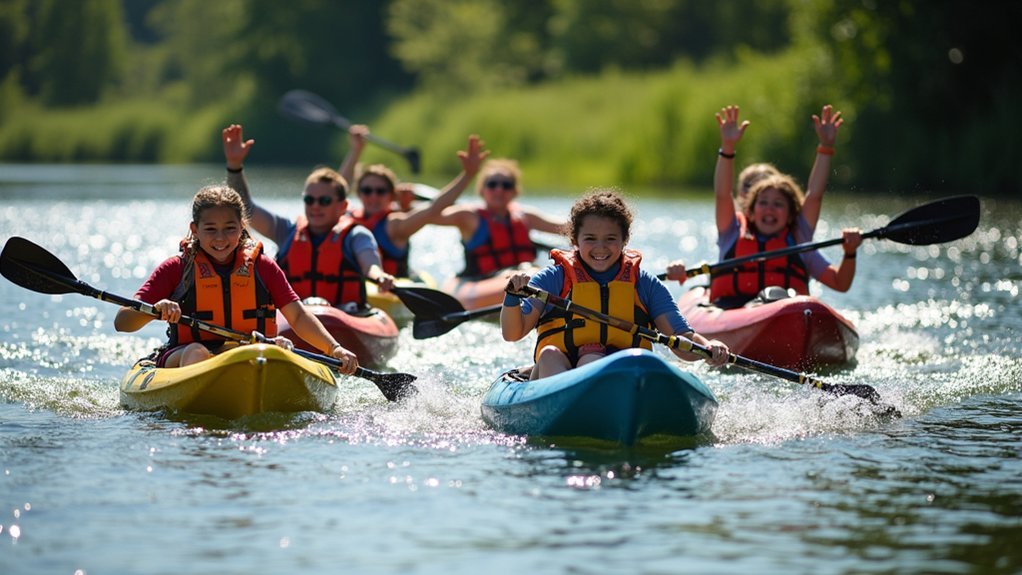
Finding the right supportive network can transform kayaking from an intimidating challenge into an accessible adventure for those with mobility limitations.
Seasonal programs like NDAA offer consistent paddling opportunities from June through October, complete with crewed support kayaks for each adaptive participant.
Experience structured paddling seasons with dedicated crews ensuring every adaptive kayaker enjoys safe, supported adventures.
You’ll benefit from extensive volunteer assistance both on land and water, ensuring safe transfers and enjoyable experiences.
Many programs provide medical screening and on-land assessments before you hit the water, plus emergency training for confidence and safety.
Look for communities that offer accessible launch sites and skill-building programs specifically designed for mobility challenges.
These groups typically provide adaptive equipment like customized seating, torso supports, and outriggers for stability—all while fostering deeper connections with nature and fellow paddlers.
The Camacho Activity Center in Austin demonstrates excellent practices through their adaptive paddling programs that promote outdoor inclusivity specifically designed for people with disabilities.
DIY Modifications on a Budget
Adapting your kayak for mobility limitations doesn’t have to drain your bank account when you explore creative DIY solutions.
With a few simple modifications, you’ll enhance your paddling experience while keeping costs manageable.
- Secure paddle hand straps using electrical or duct tape to improve your grip without expensive equipment.
- Attach waterproof magnets for convenient access to small items like water bottles or snacks.
- Install stick-on lights around your cockpit to improve visibility during early morning or evening paddles.
- Create custom seating support using adjustable cushions that offer stability and comfort.
- Use gorilla tape for quick fixes and minor adaptations that prevent sliding or improve reach.
Consider adding a simple outrigger system made from pool noodles and PVC pipe to increase stability on the water.
Unlike full adaptive setups that can cost thousands, these budget-friendly modifications deliver practical solutions while maintaining your independence on the water.
Training Programs and Building Confidence on Water
You’ll find your confidence growing through progressive skill-building programs that start with basic paddling techniques in calm waters before advancing to more challenging environments.
Many adaptive kayaking programs offer supportive learning environments with trained instructors who understand how to modify techniques for your specific mobility needs.
Building mental resilience becomes easier when you participate in regular sessions that celebrate small victories and provide community encouragement from fellow adaptive paddlers. Programs like those offered by NDAA run for approximately eight weeks during summer months, providing consistent opportunities to develop your skills in a structured environment.
Gradual Skill Development
While many paddlers jump straight into challenging waters, those with limited mobility benefit considerably from a methodical approach to skill development.
You’ll find that incremental training builds both competence and confidence as you navigate your adaptive kayaking journey.
- Start with introductory classes in calm, sheltered waters to familiarize yourself with equipment.
- Work with certified adaptive kayaking trainers who can assess your needs and create personalized plans.
- Practice consistently through structured programs (typically 8-week courses) for ongoing skill development.
- Gradually expose yourself to increasingly challenging conditions as your comfort level grows.
- Celebrate small victories and milestones to maintain motivation and track your progress.
This patient, progressive approach guarantees you’ll develop the skills needed while minimizing frustration and maximizing enjoyment on the water.
Consider scheduling an initial assessment with an occupational therapist who specializes in adaptive paddling to ensure you receive personalized equipment recommendations and training tailored to your specific needs.
Supported Learning Environments
Beyond gradual skill development lies the necessity of properly structured learning environments that can make or break your adaptive kayaking experience.
Look for programs featuring trained instructors and therapists who’ll customize techniques to your specific needs. These professionals provide invaluable guidance on proper positioning and equipment adjustments.
You’ll benefit most from group settings where peer support and observational learning enhance your progress. Organizations like Green Mountain Adaptive Sports offer weekly sessions where you can develop skills alongside others facing similar challenges.
These social environments build confidence while providing safety through community support.
The best programs combine professional guidance with calm water environments and thorough safety protocols. Organizations typically require life jackets mandatory regardless of swimming ability, ensuring everyone’s safety while building confidence on the water.
They’ll pair you with helpers and implement accessible launch areas, ensuring you’re supported from shore to water and back again.
Mental Resilience Building
Mental resilience forms the foundation of successful adaptive kayaking, especially when physical limitations present unique challenges.
You’ll build confidence through progressive skill acquisition tailored to your abilities, transforming perceived limitations into strengths.
- Visualize successful navigation scenarios before hitting the water to enhance focus and reduce anxiety.
- Set clear, achievable goals—both short-term (mastering specific maneuvers) and long-term (completing challenging routes).
- Practice mindfulness techniques while paddling to stay present and develop transferable stress management skills.
Developing positive self-talk patterns during challenging water situations can dramatically improve your performance and confidence when facing unexpected obstacles.
- Track your progress regularly to reinforce self-efficacy and commitment to your kayaking journey.
- Participate in structured programs that combine physical training with mental resilience exercises specifically designed for limited mobility adventurers.
These approaches create a positive feedback loop where each successful experience strengthens your mental resilience for future challenges.
Seasonal Considerations for Year-Round Kayaking
Despite mobility limitations, you can enjoy kayaking throughout all four seasons with proper preparation and equipment adaptations.
Summer offers ideal conditions with warm temperatures and calm waters, making it perfect for beginners still mastering transfer techniques.
Spring’s increased water flow requires stronger upper body control, while autumn demands careful layering as temperatures fluctuate. Prioritize quick-drying, synthetic materials that maximize comfort and safety when selecting your seasonal gear.
Don’t overlook winter’s unique wildlife viewing opportunities, though you’ll need specialized cold-weather gear like dry suits and neoprene gloves.
Your clothing strategy should evolve seasonally—quick-dry, UV-protective apparel for summer and insulated, waterproof layers for colder months.
Always monitor weather conditions before launching, particularly wind speeds which directly impact paddling difficulty.
Consider shortened daylight hours in winter when planning trip duration and carry appropriate communication devices year-round.
Frequently Asked Questions
How Does Adaptive Kayaking Affect Insurance Coverage?
Adaptive kayaking may affect your insurance through higher premiums for specialized equipment, potential exclusions for hazardous activities, and requirements for specific disclosures about your mobility limitations. You’ll need tailored coverage for complete protection.
Can Service Animals Accompany Paddlers With Limited Mobility?
Yes, your service animal can legally accompany you while paddling. Under the ADA, service animals have access rights to public waterways. You’ll need to guarantee both your safety with appropriate equipment and precautions.
What Medication Considerations Exist for Extended Kayaking Trips?
For extended kayaking trips, you’ll need pain relievers, anti-diarrheals, and allergy medications. Don’t forget your prescriptions, check expiration dates, and consider environmental factors like altitude medication and insect protection when packing.
How Do Different Disabilities Impact Kayaking Technique?
You’ll need to adapt your paddling technique based on your disability. Lower body limitations require more upper body work. Upper limb issues need grip modifications. Sensory impairments demand tactile cues. Neurological conditions affect coordination and fatigue management.
Are There Certification Programs for Adaptive Kayaking Instructors?
Yes, you’ll find ACA’s Adaptive Paddling Workshops provide official certification for instructors. These programs teach you proper language, equipment modification techniques, and how to safely instruct paddlers with various disabilities in an inclusive environment.
In Summary
You’ve now got the tools to embrace the freedom of water despite mobility challenges. Don’t let limitations define your adventures—adapt and overcome with the right equipment and support. You’ll find kayaking offers unique independence that’s worth the initial learning curve. Remember, every paddle stroke strengthens both body and spirit. Join the growing community of adaptive paddlers and discover waters waiting for your exploration.

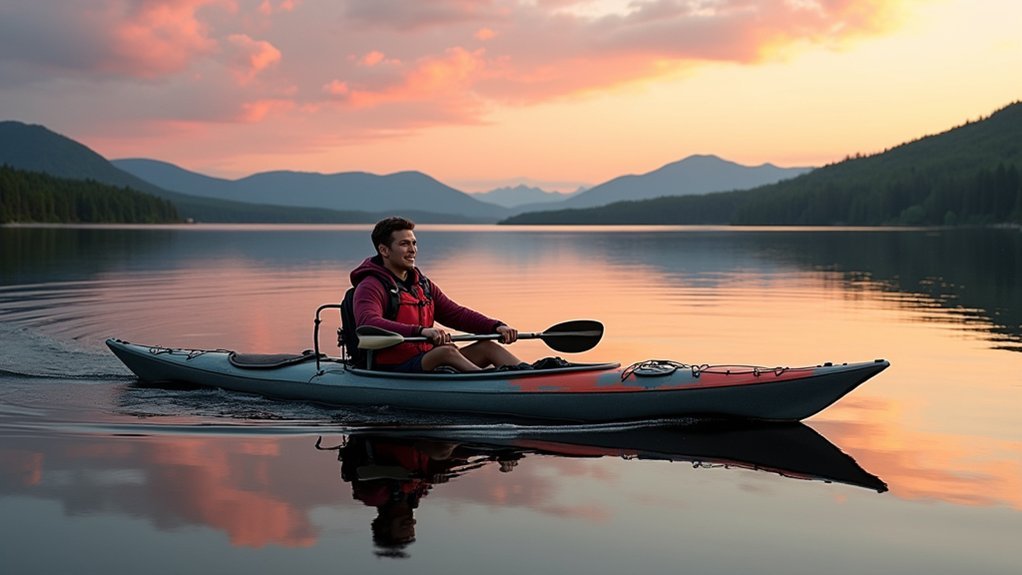



Leave a Reply